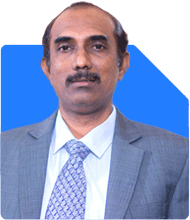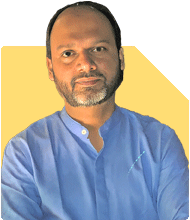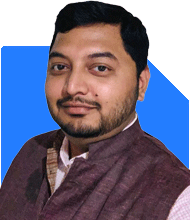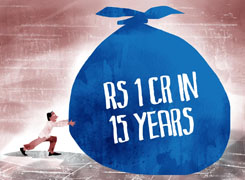Ramalingam Kalirajan |10874 Answers |Ask -Follow
Mutual Funds, Financial Planning Expert - Answered on Jul 31, 2025
He has an MBA in finance from the University of Madras and is a certified financial planner.
He is the director and chief financial planner at Holistic Investment, a Chennai-based firm that offers financial planning and wealth management advice.... more

Sir, I'm 51 years old. I'm currently working in private organisation with 30 LPA. I don't have children. My current financial position is as follows. PF - 65 lakhs A own house - loan cleared. I don't have any loans or commitments. A open plot worth 40 lakhs. 15 lakh bank balance. SIP - 5 lakhs Rental income of 30000 per month. Farm land 5 acres worth 6 crores. Please advice as I was planning to retire at the age of 60. My self and my wife are fully fit and have no health problems as of now.
At 51, with no financial dependents and no liabilities, your position is strong. Your current income, assets, and investments indicate a clear path to retire comfortably at 60. Let’s evaluate and guide you from all possible angles.
? Income and Employment Overview
– You are earning Rs. 30 lakh per annum from your job.
– Rental income adds Rs. 30,000 per month.
– No loans or EMI burden is a big plus.
– You have 9 more working years before retirement.
– Health is stable for you and your wife. This is important.
Your focus should now shift towards capital protection, inflation-proof retirement income, and creating flexibility in future choices.
? Provident Fund Assessment
– Rs. 65 lakh PF corpus is already a great achievement.
– Continue monthly PF contributions until retirement.
– This corpus can grow significantly in 9 years.
– It will form the backbone of your retirement income.
– After retirement, you may use part of PF for SWP or annuity-type withdrawals, but not annuity products.
? Bank Balance Review
– You hold Rs. 15 lakh in bank balance.
– Maintain Rs. 5 to 7 lakh as emergency fund.
– Remaining balance should be parked in liquid or arbitrage funds.
– This helps earn better returns than regular savings.
Idle cash leads to value erosion due to inflation. Keep it optimised.
? SIP and Mutual Fund Investment Analysis
– Rs. 5 lakh corpus in mutual fund SIPs is modest.
– Continue investing every month in diversified equity funds.
– Target Rs. 50,000 to Rs. 70,000 per month SIP till retirement.
– Step up your SIP by 10% annually.
– Your MF portfolio should be mix of large-cap, flexi-cap, and mid-cap.
– Add conservative hybrid or dynamic funds after age 55.
– This builds stability and lowers volatility.
Stay invested via regular plans through a Certified Financial Planner (CFP) and not direct plans.
Direct plans miss out on expert advice and portfolio review support.
Regular plans via CFP ensure handholding, rebalancing, and strategy alignment.
Also, avoid index funds.
Index funds mirror the market. They don’t beat it.
No flexibility in changing allocations based on market cycles.
Actively managed funds offer fund manager expertise and better risk control.
? Rental Income Role in Retirement
– Rs. 30,000/month rental is a good supplementary income.
– It adds Rs. 3.6 lakh yearly without risk.
– Even if post-retirement you stop working, this income continues.
– Use it as a buffer for medical expenses or lifestyle needs.
Ensure the property is well-maintained. Consider succession planning early.
? Real Estate Asset Review
– You own a residential house (loan-free).
– You own a plot worth Rs. 40 lakh.
– You also own 5 acres of farm land valued at Rs. 6 crore.
Though these are valuable, do not rely on real estate for income generation or liquidity.
As a policy, real estate is not a recommended investment instrument.
Real estate has illiquidity, high maintenance, and poor transparency.
Retirement income needs steady and easy-to-access cash flows.
You may consider partial monetisation of either plot or farmland after age 58, only if needed.
Until then, let these remain wealth reservoirs, not income engines.
? Health Insurance Coverage
– You and your wife are currently healthy.
– But medical inflation is high.
You must have the following in place:
– One family floater health insurance policy of minimum Rs. 15–20 lakh.
– Top-up policy of Rs. 25 lakh if base policy is low.
– Critical illness cover for both spouses.
– Rs. 5–7 lakh health emergency fund.
Check existing cover from employer. Buy a standalone policy now.
After retirement, premiums shoot up. It’s harder to get approval too.
? Retirement Planning Strategy
Your target retirement age is 60. That gives 9 more years.
Key goals during this phase:
– Grow corpus steadily and safely.
– Build equity-debt balanced portfolio.
– Keep risk moderate.
– Ensure liquidity at all times.
– Avoid locking funds in long-term products.
– Never chase high returns with risky products.
Post retirement, build your income stream using:
– SWP from mutual funds.
– Partial withdrawals from EPF and PPF.
– Rental income.
– Farm income if managed well.
– Use debt mutual funds for parking money safely.
Make sure to avoid:
– Annuities
– ULIPs
– Endowment policies
– Real estate investments
– Index or direct plans
If you hold any LIC, ULIP or combo investment-insurance policies, you should surrender them and shift to mutual funds via a CFP.
They give poor returns, low transparency, and poor liquidity.
? Tax Planning and Capital Gains Strategy
– Post 2025, MF taxation has changed.
– Equity MF:
LTCG above Rs. 1.25 lakh taxed at 12.5%.
STCG taxed at 20%.
– Debt MF:
LTCG and STCG both taxed as per your slab.
Plan redemptions accordingly after retirement.
Stagger withdrawals using SWP route to lower tax impact.
Continue tax-saving till retirement using:
– EPF, PPF, SIP in ELSS if needed.
– NPS if you want additional tax shield.
– Health insurance premium and standard deductions.
Avoid aggressive tax-saving schemes. Simplicity matters more now.
? Lifestyle Planning and Retirement Readiness
– Decide your expected lifestyle post-retirement.
– Estimate monthly expense today and inflate it by 6–7% yearly.
– Include travel, wellness, gifts, maintenance, contingencies.
– Don’t plan a frugal lifestyle. Keep some leisure fund.
– Try living on your estimated post-retirement income for 3–6 months.
This will help you validate your corpus needs and comfort zone.
? Estate Planning and Succession Clarity
– Since you have no children, plan succession early.
– Draft a registered Will for all properties and investments.
– Assign trusted nominee for all accounts and policies.
– Use joint ownerships to avoid legal issues.
– Keep your spouse aware of all investments, passwords, and financial contacts.
Nomination is not ownership. Will supersedes all. So don’t delay.
? Risk Management and Portfolio Review
– Avoid high-risk investments now.
– Don’t experiment with PMS, unregulated products, or fancy tax schemes.
– Stick to a well-diversified mutual fund portfolio.
– Maintain 60:40 ratio of equity and debt from age 55.
– Monitor the portfolio at least twice a year.
Involve a Certified Financial Planner (CFP) for regular reviews.
This ensures asset allocation is aligned with age and goals.
They also help you rebalance and switch tactically.
? Final Insights
– Your foundation is strong and well-prepared.
– You have no debt and ample assets.
– Just focus on disciplined investing and avoiding risky decisions.
– Allocate savings wisely across mutual funds and fixed instruments.
– Protect health and legacy with insurance and a Will.
– Your goal to retire at 60 is 100% achievable with the current plan.
A few tweaks and regular reviews will secure your financial freedom.
Best Regards,
K. Ramalingam, MBA, CFP,
Chief Financial Planner,
www.holisticinvestment.in
https://www.youtube.com/@HolisticInvestment
You may like to see similar questions and answers below
Ramalingam Kalirajan |10874 Answers |Ask -Follow
Mutual Funds, Financial Planning Expert - Answered on May 20, 2024
Ramalingam Kalirajan |10874 Answers |Ask -Follow
Mutual Funds, Financial Planning Expert - Answered on Jul 08, 2024
Ramalingam Kalirajan |10874 Answers |Ask -Follow
Mutual Funds, Financial Planning Expert - Answered on Sep 02, 2024
Mayank Chandel |2569 Answers |Ask -Follow
IIT-JEE, NEET-UG, SAT, CLAT, CA, CS Exam Expert - Answered on Dec 08, 2025
Mayank Chandel |2569 Answers |Ask -Follow
IIT-JEE, NEET-UG, SAT, CLAT, CA, CS Exam Expert - Answered on Dec 08, 2025

Mayank Chandel |2569 Answers |Ask -Follow
IIT-JEE, NEET-UG, SAT, CLAT, CA, CS Exam Expert - Answered on Dec 08, 2025
Mayank Chandel |2569 Answers |Ask -Follow
IIT-JEE, NEET-UG, SAT, CLAT, CA, CS Exam Expert - Answered on Dec 08, 2025
Mayank Chandel |2569 Answers |Ask -Follow
IIT-JEE, NEET-UG, SAT, CLAT, CA, CS Exam Expert - Answered on Dec 08, 2025
Anu Krishna |1746 Answers |Ask -Follow
Relationships Expert, Mind Coach - Answered on Dec 08, 2025
Ramalingam Kalirajan |10874 Answers |Ask -Follow
Mutual Funds, Financial Planning Expert - Answered on Dec 08, 2025
Samraat Jadhav |2499 Answers |Ask -Follow
Stock Market Expert - Answered on Dec 08, 2025
Ramalingam Kalirajan |10874 Answers |Ask -Follow
Mutual Funds, Financial Planning Expert - Answered on Dec 08, 2025
Radheshyam Zanwar |6737 Answers |Ask -Follow
MHT-CET, IIT-JEE, NEET-UG Expert - Answered on Dec 08, 2025






















